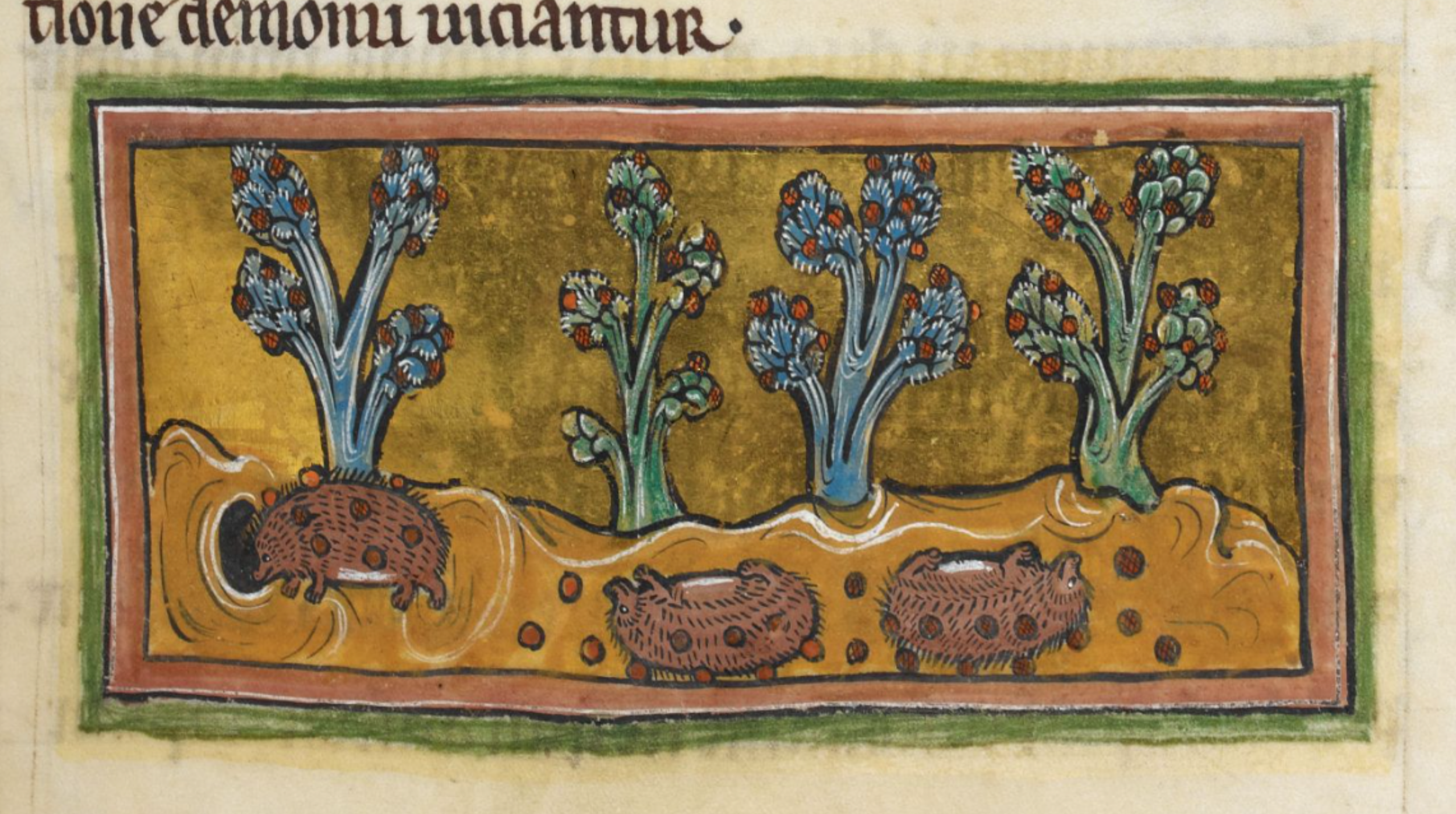
Hedgehog, Rochester Bestiary, c.1230
Search page
Search within this page here, search the collection page or search the website.
Index
Laurel, Rochester Bestiary, c.1230
Ant, Rochester Bestiary, c.1230
Hedgehog, Rochester Bestiary, c.1230
The hedgehog embodies layers of meaning that delve into the depths of human nature and spirituality. This small creature, equipped with a protective armour of quills, serves as a potent metaphor for sinners ensnared by the thorns of their own transgressions.
When danger looms, the hedgehog instinctively curls into a ball, relying on its defences to ward off threats. This defensive posture mirrors the resilience of sinners who, confronted with the consequences of their actions, seek refuge behind the barriers of their wrongdoing.

Amidst this imagery of sin and vulnerability, a deeper symbolism emerges. The hedgehog, in its act of rolling over grapes to provide for its cubs, takes on the likeness of Christ in the flesh, bearing the burden of human sinfulness and offering redemption through sacrifice.
This duality of symbolism is echoed in the prophetic words of Zephaniah, where the hedgehog is mentioned alongside other creatures in a scene of desolation. Here, the hedgehog represents both the fallen state of humanity, dwelling in the ruins of worldly glory, and the transformative power of Christ's advent, which heralds the dawn of spiritual renewal.
The pelican, with its dual nature as both aquatic and wilderness-dwelling, symbolizes the spread of Christ's message to all corners of the earth, while the raven embodies the struggle between enlightenment and sin, preaching from the thresholds of our senses and the lintels of our reason.
A clear message transpires amidst the allegories: the constant battle of the human soul between vice and virtue, sin and redemption. As the hedgehog bristles with quills of protection, we must also arm ourselves against the temptations of the world, seeking refuge in the grace of divine forgiveness.
F44v
contra insidians(changed to insidias) se spinis vallans. et cum primo
aliquid sentre; statim se subrigite. atque in globum con-
versus; in sua se arma recolligit. hoc animal cum u-
nam(changed to vam) de vite abscindit; supinus super eam volutat.
et sic eam spinis infixam; exhibet natis suis. Hericius
spinosum animal significat peccatorem. spinis pecato-
rum circundatum. Vel christum in similitudinem carnis pecca-
ti apparentem vel diabolum. Hinc per sophomam de nini-
ve dicitur. et eius desolatione futura. Omnes bestie gentium
et onocrotalus et heritius in lumbis eius morabuntur.
Vox cantantis in fenestra. Corvus in superliminari. qm atte-
nuabo robur eius. Hec est civitas gloriosa habitans in confi-
dentia. Ninive; significat mundi gloriam. que per adven-
tum christi et predicatorum eius desolata est. Onacrotalorum(changed to Onocrotalorum)
duo sunt genera. Aliud aquatile. aliud solitudinis.
F45r
res christi; verba christi usque ad fines orbis terrarum dissemi-
nantes. tan in iudea; quam in solitudine gentium. Heritius
est ipse christus. tectus similitudine carnis peccati. vel pre-
dicator spinis sententiarum subtilium; peccata nostra;
delens.Corvus est predicator gentilis. qui niger fuit
in pccatis. sed in adventu christi; cantate predicando; in
fenestra sensuum nostrorum. et in superliminari; videlicet
menti nostre sapientie verba infigens. Vel in ma-
lam partem totum legi potest. Per hec enim animalia
que omnia inmunda sunt; significantur vicia vel de-
monia que habitant in anima per ypocrisis similitudi-
nem; spinosa vel speciosam added. et mentis rationem. et sensus nostros se-
ducunt. Limen enim; corpus vel sensualitas est. Super
liminare autem anima vel ratio. que omnia seduc-
tione demonum viciantur.
Bibliography
David Badke, The Bestiary Blog: Animals in the Middle Ages, Hedgehog, November 6 2023, https://bestiary.ca/beasts/beast216.htm
Josh Goldenberg (BA 2012) and Matt Shanahan (BA 2014), Logeion, November 2022, https://logeion.uchicago.edu/
Castiglioni, L. and Mariotti, S. (1996). Vocabolario della Lingua Latina: Latino-Italiano Italiano-Latino. Terza Edizione. Loescher Torino
Curley, M. J., Physiologus: A Medieval Book of Nature Lore (University of Chicago edition 2009)
Rackham, H., M.A., Pliny Natural History Volume III, Libri VIII-XI (London: William Heinemann Ltd, 1949)
Collins, A. H., M.A., Symbolism of Animals and Birds (New York: McBride, Nast & Company, 1913)
Henderson, C., The Book of Barely Imagined Beings (London: University of Chicago Press, 2013)
White, T. H., The Bestiary: A Book of Beasts (New York: G.P Putnam’s Sons, 1960)
Barney, S. A., Lewis, W. J., Beach A., Berghof O., The Etymologies of Isidore of Seville (New York: Cambridge University Press, 2006)
